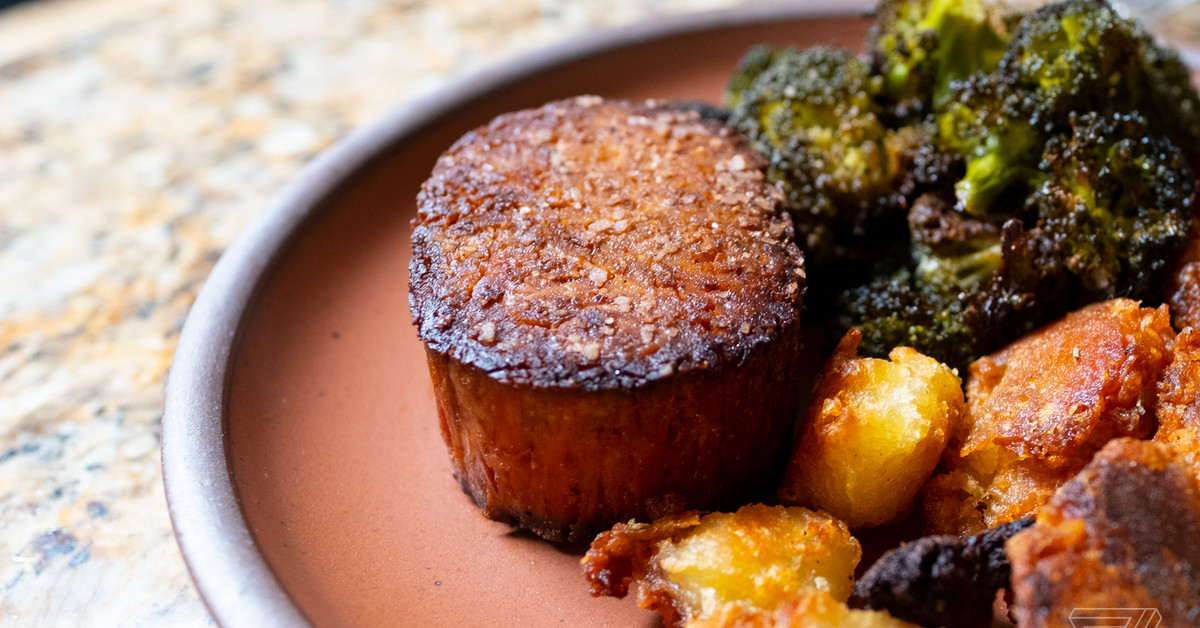It’s hard to stand out in the world of plant-based meats, but Juicy Marbles is trying to do so by attempting to replicate not just a steak but also one of the higher-end cuts: the filet mignon. When the company reached out to The Verge asking if we wanted to try its steaks, its promises of a tender filet that’s marbled and cooks like a real steak caught my attention, as someone who swore off eating meat for two years (but who still gets a little jealous of the delicious-looking things my wife eats). The price also caught my attention — $40 for a four-pack of four-ounce steaks. For the mathematicians at home, that’s $40 a pound.
Having eaten plenty of plant-based meats, though, I know that marketing materials can be very deceiving and that being expensive doesn’t automatically equate to tasting good. Keeping my hopes in check, I asked them to send me and my co-worker Alex Cranz, a person so committed to beef I think Hank Hill might have been modeled after her, some steaks. The plan was to get both a vegetarian and carnivorous perspective.
Soon enough, the steaks had arrived, swaddled in dry ice. While I was preparing to cook them, I noticed that the raw steak smelled very similar to raw Beyond Burger. That concerned me a little. While I do thoroughly enjoy a good plant-based hamburger, they often have a weird, indescribable taste that starts to seep in if the patty is too thick. (For example, I enjoy the Burger King Impossible Burger but not Red Robin’s, which is significantly heftier.) At the time, I didn’t know that it wouldn’t really end up tasting anything like a hamburger patty, so with some extra trepidation, I set about cooking it.
It’s been a second since I’ve cooked a “real” steak, and my go-to method was always… a little unconventional. For this test, I wanted to try the Juicy Marbles steak in its purest form, so I limited my seasoning to just salt and pepper and cooked it following Gordon Ramsay’s guide for literal children. Basically, I seared it on both sides, basted it in butter, and then rolled it in the pan to cook the edges. The filet definitely browned and crisped up, but I can’t say that it looked shockingly steak-like; to be honest, it kind of reminded me of an extra thick (and a little burnt) McDonald’s hash brown.
I could tell that the texture of the Juicy Marbles filet wasn’t going to be particularly convincing the second I cut into it, and my knife basically slid right through it. Looking at the inside, it was easy to see why. Juicy Marbles’ fake meat fibers are way bigger than in an actual steak. In fact, they’re almost identical to what you’d find in a slow-cooked pot roast.
:no_upscale()/cdn.vox-cdn.com/uploads/chorus_asset/file/23761222/JM_Texture_Macro.png)
The taste doesn’t do anything to dispel that impression either. To be clear, to my tongue, it very much tastes like beef. I genuinely might have been fooled that it was an actual chunk of roast if it were in a stew or already shredded on a plate. But it did not taste like steak. My wife, who does eat meat, had pretty much the exact same conclusion. (I didn’t tell her what I had thought of it before she tasted it.) When I asked Alex how her experience had gone, she seemed even less impressed.
:no_upscale()/cdn.vox-cdn.com/uploads/chorus_asset/file/23963144/Screenshot_2022_08_22_at_11.18.38.png)
:no_upscale()/cdn.vox-cdn.com/uploads/chorus_asset/file/23963144/Screenshot_2022_08_22_at_11.18.38.png)
:no_upscale()/cdn.vox-cdn.com/uploads/chorus_asset/file/23963144/Screenshot_2022_08_22_at_11.18.38.png)
:no_upscale()/cdn.vox-cdn.com/uploads/chorus_asset/file/23963144/Screenshot_2022_08_22_at_11.18.38.png)
Someone I didn’t exactly expect to agree with my conclusion was Vladimir Mićković, Juicy Marbles co-founder. But when I talked to him, he freely admitted that the company had some work to do. “I think the texture is one thing that’s the thing that gets a lot of positive feedback as well as that it’s not exactly like steak,” he said. “That’s the biggest challenge, I think, because if you look at a medium rare steak, it’s got two different textures. The middle stays very jello-like and chewy, while the outside kind of becomes similar to what we have and it gets these fibers that are pronounced. So it’s not quite realistic there.”
As someone who’s eaten maybe one or two cow-based filets mignons in my whole life, I’m not really one to judge how accurate that description of a real steak is. However, it doesn’t quite match up with how renowned food writer J. Kenji López-Alt describes tenderloins (which are where filets mignons come from). In “The Food Lab’s Definitive Guide to Grilled Steak,” he writes that they should have an “almost buttery texture” and that a well-cooked steak “should have a crusty, crunchy, well-browned exterior surrounding a core of perfectly pink, juicy, tender meat.” To me, at least, I wouldn’t describe Juicy Marbles’ thick fibers as being particularly crust-like, nor would I say that a chewy interior is the same as a tender, buttery one.
I’ll also note that the Juicy Marbles steak also completely failed to live up to the texture and behavior of the real thing when I tried to make a Philly cheesesteak with it. Instead of slicing into thin strips, the filet mostly just crumbled into cubes. It didn’t make for a great sandwich.
:no_upscale()/cdn.vox-cdn.com/uploads/chorus_asset/file/23761221/IMG_4679.png)
:no_upscale()/cdn.vox-cdn.com/uploads/chorus_asset/file/23761221/IMG_4679.png)
:no_upscale()/cdn.vox-cdn.com/uploads/chorus_asset/file/23761221/IMG_4679.png)
:no_upscale()/cdn.vox-cdn.com/uploads/chorus_asset/file/23761221/IMG_4679.png)
Mićković says that the company has also gotten feedback about Juicy Marbles’ flavor, with people saying that it doesn’t taste exactly like steak. “I think there were certain people who were kind of offended that we called it filet mignon,” he laughed. “Which I do understand. Because to somebody if that means a lot to them, and they are really used to that thing being a specific experience… I kind of get it.”
To some extent, it seems like getting that kind of feedback was what Juicy Marbles wanted. It’s been selling small batches of steaks on its website, seeing how people react, and setting up internal teams to work on solving the problems people have. Apparently, there’s a team dedicated to making Juicy Marbles’ steak juicier after they got complaints that the steaks turned out dry. “You can fuck it up,” Mićković said. “In the sense that is like meat, you can definitely make a dry-ass piece of Juicy Marbles as well.” (Alex confirmed this to me by saying “lmao I did.”)
In fact, Mićković told me, “What you ate is kind of the old version. Already we have a new one to deploy, which is going to come later this year, which we’re going to get a completely new flavor mix.”
This sort of iterative approach isn’t uncommon in the fake meat industry. Both Impossible and Beyond introduced “2.0” versions of their hamburger patties, and Simulate has done something similar with its chicken nuggets. The differences between versions have sometimes been dramatic — the first time I had a Beyond Burger I could barely finish half of it, but I think the company’s current patties rival Impossible’s.
Having only tasted one iteration of Juicy Marbles, it’s hard to say how fast it’s improving toward being like a real piece of beef. I would say, though, that there’s a bigger gap between the filets and actual steak in terms of texture than there was for my first Beyond Burger, but Juicy Marbles is slightly closer on taste.
Mićković does seem to want to take a page from those companies in other ways as well. He told me that the company wants to start selling its products in restaurants and retail outlets in the next few months to avoid having to use “all that dry ice and fucking packaging” that the steaks currently come in, which happen to be very expensive in addition to being relatively wasteful.
But getting onto store shelves and the company’s goal to drive the price of Juicy Marbles down to be “ridiculously low” are both way easier said than done. The company will have to start operating at scale to make its steaks cheaper and to have enough of them to sell to stores and restaurants, and it’ll be competing for space in the plant-based aisle with established competitors that have spent years on getting their supply chains going. (Personally, I wouldn’t want to have to compete with Kellogg’s, a massive player in the space.)
Even if Juicy Marbles does manage to get its steaks onto store shelves, people will actually have to like them and decide that the price tag is enough to keep buying them. Plus, how often do the companies that are early to market with a product end up on top? (Hint: McDonald’s isn’t partnering with VegeBurger or Boca to launch the McPlant.)
What I’m saying is that making the steak more realistic is just one of the many things Juicy Marbles has to do to succeed. But whether it is the one to really crack the code, I’m glad it, and other companies like Beyond Meat (which recently announced that it’s working on making steaks, too), are pushing to make plant-based steak a thing. While I’m not the type of person who eats a lot of alternative meats, it’d be great to have unground beef as an ingredient in a potato stew. I’d genuinely be interested in the Juicy Marbles steak I tried for the latter if the price were a little lower. As an alternative to the occasional fancy steak dinner, though? I think the Juicy Marbles may need to marinate for a little longer.
By the way, and apologies for the not-so-subtle plug: if you’re interested in fake meats, check out The Verge’s show on Netflix, The Future Of. Episode 6 goes into what cheeseburgers could look like in the next few decades.
Credit: Source link



